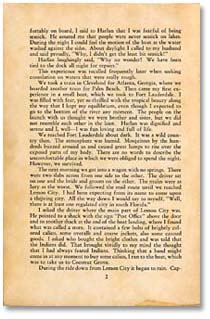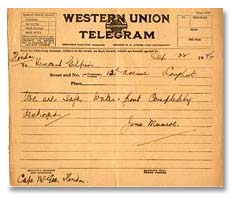|

Pioneer Reminiscences
Despite efforts to make South Florida habitable for
development and settlement, many features of the tropical environment made some
visitors somewhat reluctant to stay.
In 1895, when native Iowan Minnie Trapp
traveled to South Florida with her new husband Harlan Trapp, she described the
setting this way: "It was a wild country then. The atmosphere was humid. Mosquitoes by the hundreds buzzed
around us and caused great lumps to rise over the exposed parts of my body.
"
Despite the discomfort, though, she and family stayed in the area that became
Coconut Grove, for the beauty of the tropical sunset over the lush foliage
helped her overcome her reluctance.
 Western Union telegram, September 28,1926
Western Union telegram, September 28,1926
While mosquitoes were one feature of the tropical climate that caused
discomfort, an even more menacing element was hurricanes. At the height of
the South Florida land boom of the 1920s, the region experienced one of its most
devastating hurricanes to date. On September 17, 1926 and into the morning hours
of the 18th, powerful winds knocked out electricity and telephone service,
felled tress, overturned boats, and demolished houses.
Over 100 people died in the storm, while eight times that number
were hospitalized. National newspapers featured headlines like "South Florida
Wiped Out in Storm." The hurricane ended the land boom even before the Great
Depression did, and became a feature of life in South Florida that subsequent
builders and residents would have to contend with.
While several more hurricanes hit the region over the next fifty
years, none would be as damaging as Hurricane Andrew in 1992, which brought with
it storm damages estimated at close to $30 billion and left 250,000 people
homeless.
|



